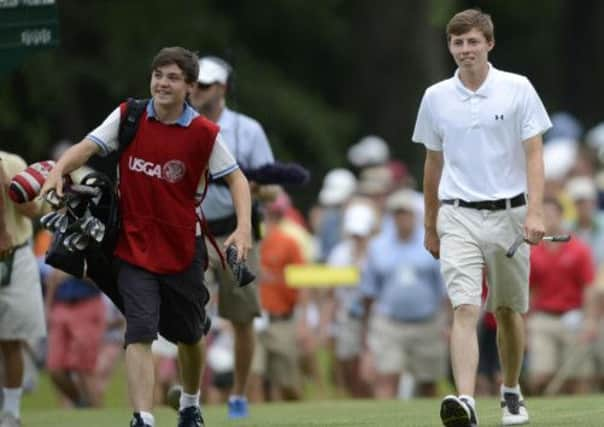Fitzpatrick’s glory at Brookline stirs memories of ‘cocksparrow’ Ouimet, four-foot tall Lowery and the watershed 1913 US Open


For Brookline, scene last weekend of Sheffield teenager Fitzpatrick’s momentous US Amateur Championship victory, was also the venue for one of the most seminal moments in the sport’s rich tapestry.
One hundred years ago this summer, an unknown amateur by the name of Francis Ouimet defeated the all-conquering visiting Britons of Harry Vardon and Ted Ray over two days of golf and a further 18 holes of a play-off.
Advertisement
Hide AdAdvertisement
Hide AdOn the bag of the 20-year-old, who had grown up by the side of 17th hole at Brookline and worked as a caddie to help improve his game, was a young boy by the name of Eddie Lowery.
Lowery was just 10 years of age, stood four-foot tall and skipped school to carry Ouimet’s bag.
He had persuaded Ouimet, who was self-taught after borrowing old clubs and balls from his brother, to let him carry his bag only minutes before the Massachusetts amateur champion took to the course for his first competitive round.
The two of them began qualifying for the two-day US Open as not even an after-thought, but as Ouimet grew into the tournament, the pair became synonymous with a home challenge geared to stopping one of the two Britons heading home with the prize.
Advertisement
Hide AdAdvertisement
Hide AdVardon and Ray were the great players of the era. Vardon had won the Open five times and the US Open once in 1900. There was no Masters or US PGA Championships in those days.
His victory at the US Open at the Chicago Golf Club elevated Vardon from a British star to an international superstar, but he did not return to the States again until 1913.
Ray had won our Open Championship in 1912, and the pair arrived in America on a golfing tour of the country, playing in matchplay exhibitions where they took money off the best professionals in the country before heading to Massachusetts in early September for the US Open, later that month.
The arrival of the two was front page news in Boston, and the onus on beating them in front of an expectant home crowd fell on the shoulders of Walter Hagen and John McDermott, among others, two of the great big hopes of American golf.
Advertisement
Hide AdAdvertisement
Hide AdAfter finishing second behind Vardon in the qualifying round – Ray would qualify first the following day – people started to sit up and take note of the young amateur.
On day one of the tournament, Ouimet shot 77, 74 to sit in a tie for seventh, two strokes behind Ray and four behind Vardon, who held a share of the lead with Wilfred Reid.
Even after showing he belonged with the high-profile professionals, Ouimet came under pressure from tournament organisers to quit the tournament, to leave the professionals to it.
Together, Ouimet and Lowery were causing embarrassment to certain members of the heirarchy, but it served only to make them stronger.
Advertisement
Hide AdAdvertisement
Hide AdIn the heavy rain on the second day, the young, unwelcome Ouimet fired a round of 74, out-shooting Vardon and Ray to move into a tie with them at the top of the leaderboard.
His course knowledge in the pouring rain that day had come to the fore.
In the afternoon, Vardon and Ray shot 79s, which Ouimet matched despite at one stage having one hand on the trophy with a five-shot lead.
The great golf correspondent of the Times, Bernard Darwin wrote, in a passage used in Mark Frost’s uplifting book The Greatest Game Ever Played: “Mr Ouimet’s golf today was astonishing. I do not believe any golfer has ever been under greater strain.
Advertisement
Hide AdAdvertisement
Hide Ad“When all the rest of the American golfing strength was stiff and cold, as we say, after its desperate, exhausting and fruitless struggle to stop the advance of my countrymen, this little cocksparrow of a Ouimet came out at the very last hour and pulled them up.”
Tied for the lead, the three men returned the following day for the 18-hole play-off. Still, many thought that when stood toe to toe with the prize on the line, Vardon and Ray would crush the young upstart amateur and fight for the title between themselves.
But as Lowery, who was wise beyond his tender years, said to his employer: “Let’s just play our own game”.
They did and Ouimet shot 72 in the play-off to win the US Open by five shots from Vardon, and seven from Ray.
Advertisement
Hide AdAdvertisement
Hide AdThe whole episode was a watershed for golf, a pastime which on the opposite side of the Atlantic had hitherto been a minority sport. America had a new conquering hero, and although he would never again scale such heights, his name will forever resonate through the golfing ages. As will that image of Ouimet and his young caddie, soldiering on under the weight of his employer’s clubs.
One hundred years on another young amateur with a boy by his side, claimed a slice of golfing history and immortality at Brookline.